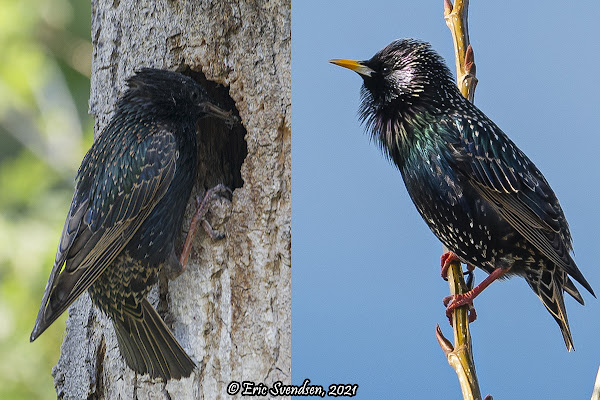Starlings - Wonderful visitors or terrible curse?
A couple of days ago I wrote a blog that accused starlings of being "flying rats." I have to tell you, that created quite a stir. Some thought the post was hilarious, others were perplexed at the moniker, and some were somewhat offended that I should name-call such a beautiful and common bird. So, I felt I needed to do the topic a little more service and research it a bit more. Here's what I found.
What do you think? Are they welcome, a problem, beautiful, ugly, or just another bird? Leave a comment if you like. Thanks for participating.
References
www.smithsonianmag.com/science-nature/the-invasive-species-we-can-blame-on-shakespeare-95506437/
https://digitalcommons.unl.edu/cgi/viewcontent.cgi?article=1036
Thanks for reading. Ericspix Eric Svendsen
- On March 6, 1890, a fan of Shakespeare released 60 starlings in New York. Starlings were not native to North America and their arrival marked the beginning of an amazing expansion.
- Today over 200 million starlings cover our continent. They all came from those same 60 birds released over 130 years ago.
- Starlings have a head that allows them to get food where most other birds would fail. They can force their bill into the ground, open it up to grasp prey, and while down there use their binocular vision to hunt around. This is especially helpful in colder climates.
- They are cavity nesters. They rely on some hidden confined space to raise their young. They will use holes in trees but are equally at home inside a horizontal metal pole with access to the outside (see this link).
- Starlings will "bully" other birds out of their nesting sites. They can't get into smaller holes (my bird boxes use holes big enough for swallows and chick-a-dees but too small for starlings). It is not uncommon for them to displace woodpeckers, bluebirds, and nuthatches by forcing them from the nests (see this link).
- Starlings are omnivorous and feed on insects but have a preference for grubs found in average lawns. They will eat fruits and seeds and will take livestock rations occasionally. They will also take food from your feeders (see this link).
- Starlings are very good mimics and are capable of recreating sounds from other birds, machinery, and even voices (see this link).
- Starlings will sometimes form large flocks called a murmation (see this link).
- Starlings belong to the same family of birds as the mynah bird, which explains their talking ability. There are quite a few species of starling, this site looks at the ten most beautiful.
- People actually hunt and even eat starlings. I watched a couple of Youtube videos on the subject and I won't provide links to them because they will certainly upset bird lovers. However, if you are curious, type in "eating starlings" into a Youtube search box and see what you get. Be forewarned though, most people will find it bothersome if not offensive.
- A cull is an event where large numbers of organisms are deliberately killed because there are just too many of them and they are causing significant problems. There recently has been a cull of Canadian Geese in Vernon. The Okanagan has also been the source of starling culls. The starlings locally were called "rats of the sky" and in 2018 a plan was hatched to remove a large number of them (click here).
What do you think? Are they welcome, a problem, beautiful, ugly, or just another bird? Leave a comment if you like. Thanks for participating.
References
www.smithsonianmag.com/science-nature/the-invasive-species-we-can-blame-on-shakespeare-95506437/
https://digitalcommons.unl.edu/cgi/viewcontent.cgi?article=1036
Thanks for reading. Ericspix Eric Svendsen




They also took over bluebird nesting sites thereby greatly reducing their numbers.
ReplyDeleteYes, that is one of my greatest problems with them. Nest boxes can be built that allow bluebirds to enter and keeps starlings out - they tend to have thin and wide bottom access holes. I saw some in the Okanagan.
Delete